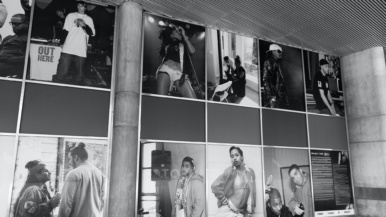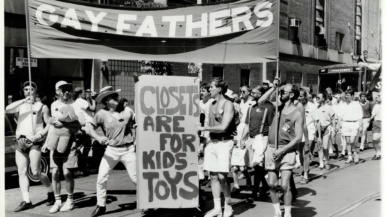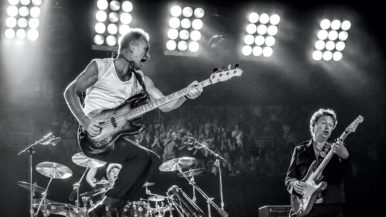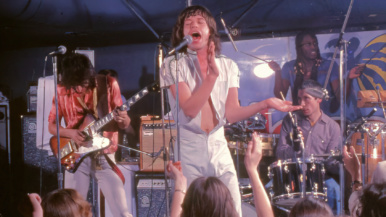These vintage photos reveal the glamour of Toronto’s old-timey movie theatres

Doug Taylor first visited a movie theatre when he was six years old, in the mid-1940s. The experience felt sinful—his grandma described cinemas as “dens of iniquity”—and he couldn’t wait to do it again. Soon, Saturday matinees became a weekly ritual—tickets cost 10 cents, popcorn five. “The world of film was my form of escapism, long before I had ever heard of the term,” he says. “It allowed me to visit exciting foreign lands and exotic climes.”
Taylor, now a historian, blogger and retired teacher, recently set out to preserve the memories of the shuttered theatres of his youth. He combed the city’s and province’s archives, conducted research at the Toronto Reference Library, and collected his and other moviegoers’ memories. The result is Toronto’s Local Movie Theatres of Yesteryear, a charming catalogue of the city’s oldest cinemas. In these excerpts, Taylor recounts fascinating stories from some of his favourite theatres.
St. Clair Theatre

“After my father immigrated to Toronto [from Newfoundland] in 1921, St. Clair Theatre was a favourite hangout for him and his six brothers, since they were living nearby on Earlscourt Avenue. On warm evenings they often cruised along St. Clair, attempting to catch the eye of a pretty young woman. If my dad was successful, he invited the gal to attend the St. Clair Theatre. During the show, somehow his arm found its way around her shoulder. Perhaps my grandmother overheard my father’s stories about the theatre and this was one of the reasons she objected to movie theatres, fearing that they promoted promiscuous behaviour.”

“The St. Clair has the distinction of being the only theatre in the world visited by my grandmother. She saw the movie Captains Courageous there in 1937. She lived to be 96 years old and never again darkened the doors of a theatre.”
Vaughan Theatre

“When I was 10 years old, my parents [found] a newspaper delivery route for me. I delivered the Toronto Star to over sixty customers on our street. Papers sold for three cents, and in my eyes, the profits from my business enterprise were immense…. Because I had newspapers to deliver, it was important that I return home by 5 p.m. However, I must admit that after attending a matinee at the Vaughan, my customers sometimes waited longer than usual for their papers. I never explained to them why I was late. Visiting the Vaughan was worth the risk of losing a customer.”
Oakwood Theatre

“The theatre always screened two films, and between films, patrons who wished to enjoy a cigarette went out on the street to smoke. A friend and I sometimes mingled with the smokers and strolled in without purchasing a ticket. We considered this a ‘real lark,’ as we used to say…. One of my cousins worked at the Oakwood Theatre in the 1950s as an usherette. We all envied her, as we knew that while showing people to their seats, she was able to catch a glimpse of the movies. On evenings when there were few patrons, she could stand at the back of the theatre and watch.”
College Theatre

“The theatre was immensely popular during the 1920s, but the years of the Great Depression were financially difficult, as it was not easy to fill a theatre of its size. However, during the 1940s, it thrived, as many of the factories supporting the war industries were located in the west end of the city, within easy travelling distance of the theatre.”

“On July 6, 1953, in the doorman’s room, there was a fire that was quickly extinguished by the manager. The audience was ordered to exit the theatre by the fire marshal, but 400 patrons refused to leave until emergency tickets were given out. Obviously they believed that there was no real danger or they would have departed the building quickly. They were correct, as the fire only inflicted $400 worth of damage.”
Midtown Theatre

“When I was a teenager in the 1950s, for two summers I was employed at the Dominion Bank (now the TD) on the southeast corner of Bloor West and Bathurst Streets. The bank’s largest customer was a relatively unknown merchant named Ed Mirvish, who had converted two old houses on the southeast corner of Bloor and Markham Streets into shops. Mirvish eventually took over the entire block, creating the famous Honest Ed’s bargain store…. Part of my job was to deliver bank drafts to the shops between Bathurst Street and Ossington Avenue. I often strolled past the Midtown Theatre. During these years it was screening mostly horror flicks. I was fascinated by the colourful posters outside the theatre and often gazed up longingly at the movies listed on the marquee.”
Brock Theatre

“The canopy over the entrance was extravagant and attracted attention at the street level, especially when its lights flashed in the darkness of a moonless evening. Unfortunately, moonless evenings were ideal for those with criminal intent. In February 1949, a man with a nylon stocking over his head pushed his arm through the window of the box office and punched the stomach of the young girl selling tickets. The robber waved a revolver in her face, but instead of handing over the cash she pushed the alarm buzzer. The manager immediately rushed to the scene, and the man fled.”
Odeon Hyland

“The Odeon Hyland was one of my favourite theatres. On Saturday evenings, I often travelled westward on the St. Clair streetcar to Yonge Street to view a film at this ultramodern theatre. Similar to those of the Odeon Fairlawn, the glass entrance doors gave access to an impressive lobby, fully visible from the street.”

“When the theatre opened on November 22, 1948, it possessed one of the largest auditoriums in the city, containing over 800 seats on the ground floor and almost 500 in the balcony. I remember that the seats had dark red and grey upholstery and that they were extremely comfortable.”
Island Theatre

“Today, it might seem strange to open a movie theatre on the islands, considering that Toronto’s summers are short and the weather is notoriously unpredictable. However, in 1951, in addition to the influx of summer tourists, the islands had a considerable number of permanent residents. Its school had 450 pupils and enrolment was rapidly expanding.”

“However, the theatre’s attendance did not continue to grow, and its finances were soon in trouble. I sometimes wonder if the reason was because many people who travelled to the islands simply preferred the outdoor space, rather than sitting inside a movie house…. The final nail in the coffin was when Metro Toronto unveiled a new plan for Centre Island that did not include maintaining a residential community. Although demolition of the homes did not commence until the 1960s, the writing was on the wall.”
Downtown Theatre

“The Downtown was one of my favourite theatres when I was a teenager. It offered double-bill screenings for a single admission price. My budget was tight back then, as I earned pocket money working weekends in a Dominion store. When my friends and I travelled downtown, the theatre attracted us, as it often featured risqué films and horror movies. The Downtown was also located near budget restaurants and had easy access to the subway.”
Allen’s Danforth Theatre

“In 1919, one year after the opening of the Prince Edward Viaduct (Bloor Viaduct) across the Don Valley, two entrepreneurial brothers, Jule and Jay Allen, opened a theatre at 147 Danforth Avenue, not far from the eastern side of the viaduct…. In the 1970s, I worked for two years near Danforth and Pape Avenues and passed Allen’s Danforth many times while travelling on the old PCC (Presidents’ Conference Cars) streetcars on the Bloor line…. By that time it had become somewhat shabby.”

“The Danforth Music Hall reopened in December 2011, with improved seating and a new sound system. It is today one of the best venues for live entertainment in the city.”
Parkdale Theatre

“The Parkdale Theatre…is another of Toronto’s theatres that I can readily recall, though I never was inside its doors. As a child in the 1940s, I often gazed at its showy marquee from the windows of the Queen streetcars on our way to Sunnyside Beach for a day beside the lake.”

“Despite its original opulence, as the years progressed the Parkdale slowly lost in the competition with television. The theatre closed on July 6, 1970. The building on Queen Street in Parkdale remains today, but has been converted into shops that specialize in second-hand and antique furniture.”
Alhambra Theatre

“Every morning when I alighted from the Bloor streetcar on my way to work, the first thing that caught my eye was the imposing Alhambra Theatre…. The feature that I remember the most was the magnificent marquee, which swept across the front, advertising the two daily features. In the 1950s the theatre was no longer screening the latest Hollywood hits, but it remained competitive with the other theatres in the area…. The bank where I worked is now a takeout pizza restaurant, but at least the building survives. Unfortunately, the Alhambra was demolished.”
Eglinton Theatre

“The theatre cost $200,000 to construct, an enormous amount of money during the Great Depression. The 800-seat auditorium was recessed from the street, parallel to Eglinton Avenue. Shops flanked the south side of the theatre that fronted on the sidewalk. The rent from these stores helped to offset the expenses of operating the theatre. The huge curved marquee covered the entire entrance area, the sign above it boldly displaying the name of the theatre. The sign was one of the tallest in the city, rivalling the great sign of the Imperial Theatre on Yonge Street.”

“The Sound of Music screened [here] from March 10, 1965, to December 21, 1967. Twentieth Century Fox Studios, the producers of the film, insisted on handling the opening night in Toronto. Though they did not own the theatre, they shipped new projectors from the United States, encased in bubble wrap. A new screen was installed to permit the film to be viewed in Todd-AO. Further improvements included new seating and carpeting. The studio also brought in their own staff for opening night, insisting that the Eglinton’s regular staff step aside.”
Revue Theatre

“The Revue Theatre…is one of the oldest surviving movie houses in Toronto, its only rival for this distinction being the Fox Theatre on Queen Street East. Both theatres opened between 1912 and 1913 and remain active today. Their façades are unchanged from when they opened, although the original marquees on both theatres have been removed as they were too costly to maintain. Because of the Revue’s location, I was never inside it as a teenager. However, in 2013, during Doors Open Toronto, I journeyed on the streetcar to visit it…. On arrival I was impressed with the young volunteers who enthusiastically talked about the Revue and provided tours of the space behind the screen. They also allowed access to the projection room. Free popcorn was available at the candy bar—a generous touch.”










